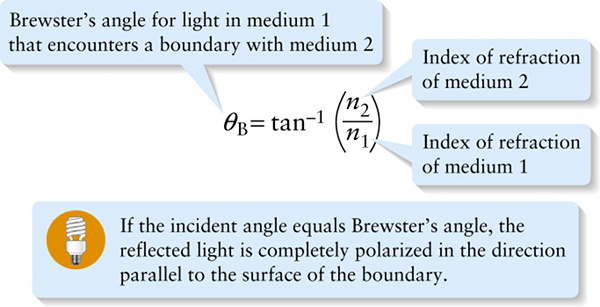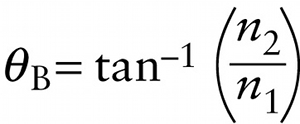Brewster’s angle for polarization by reflection (23-14)
Question 1 of 3
Question
Index of refraction of medium 1
{"title":"Brewster’s angle for light in medium 1 that encounters a boundary with medium 2","description":"Wrong","type":"incorrect","color":"#99CCFF","code":"[{\"shape\":\"poly\",\"coords\":\"82,133\"},{\"shape\":\"rect\",\"coords\":\"10,16,12,16\"},{\"shape\":\"poly\",\"coords\":\"144,22\"},{\"shape\":\"rect\",\"coords\":\"4,46,31,86\"}]"} {"title":"Index of refraction of medium 2","description":"Incorrect","type":"incorrect","color":"#008000","code":"[{\"shape\":\"rect\",\"coords\":\"236,17,261,43\"}]"} {"title":"Index of refraction of medium 1","description":"Correct!","type":"correct","color":"#ffcc00","code":"[{\"shape\":\"rect\",\"coords\":\"232,74,265,101\"}]"}Review
The sine of an angle divided by its cosine equals the tangent of the angle. So tanθB=n2/n1, or

If the angle of incidence for unpolarized light is something other than θB, the reflected ray is partly polarized. If unpolarized light strikes the boundary perpendicular to it, so θ1=0, there is no change in polarization of the reflected light.
